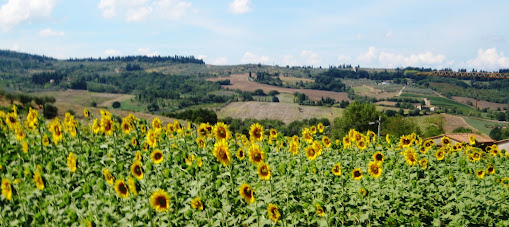San Michele a Torri, July 1944 - the story of Antonietta
San Michele a Torri - la storia di Antonietta

Le altre foto mostrano la chiesa, il campanile, la casa di Antonietta, e la scuola dove sua madre insegnava, gravemente danneggiati dalla battaglia di San Michele, l’ultimo aspro scontro fra i Nazifascisti e gli Alleati prima della liberazione di Firenze. Antonietta, figlia della maestra e di un bracciante, ormai aveva quasi 15 anni. Troppi per dimenticare l’orrore e il dolore provocati da quei giorni del passaggio del fronte. In quella battaglia ha perso tutto ciò che le era familiare – casa, scuola, chiesa - e anche suo padre, morto di ferite non curate per tempo. Da giorni, fino al momento della liberazione, il 30 luglio 1944, Antonietta e i suoi genitori si trovavano stipati con tante altre famiglie nella cantina della fattoria di San Michele, dove lavorava il padre. Furono soldati della Seconda Divisione neozelandese ad aprire le grandi porte della cantina che davano sul versante dietro la casa. Mandarono il padre di Antonietta all’ospedale militare di Siena, ma non fece più ritorno.
Con la madre, tornò in paese attraversando un paesaggio irriconoscibile, spettrale. La loro casa era in rovina, e i materassi macchiati di sangue si trovarono in cortile. Erano stati usati come giacigli per i feriti. Non rimase niente. Senza casa, senza marito e senza lavoro, con una ragazzina da crescere, la madre dovette ricominciare. Si trasferì in un altro paese, dove fece la sarta per mantenere lei e la figlia, e tirare avanti.
Antonietta,
che molti anni dopo è ritornata a San Michele, ha portato dentro per tutta la
vita il doloroso ricordo di quei giorni – l’inferno dei bombardamenti e dei
giorni nel rifugio sotto il fuoco incrociato delle artiglierie, lo straziante
addio al padre, la disperazione della madre, gli anni di esilio dal suo paese. E
ricordava sempre quel primo incontro con i soldati neozelandesi, che
spalancavano le porte della cantina della fattoria, invitando i civili ad
uscire.
*****
 |
| The church and belltower of San Michele (Antonietta's house left), seen from the back, at the end of the battle (NZ Archives photograph WH24BaP001a) |
The Battle of San Michele, an outlying hamlet of Scandicci (Florence) took place in the last days of July 1944. One of the many little ridge-top villages of the Apennines to the south of Florence, San Michele was contended by the defending German occupiers, and the advancing Allied forces, in this case, the 6th Brigade of the 2nd New Zealand Division. For its strategic location, commanding one of the main routes to Florence, San Michele was subjected to heavy crossfire which reduced much of it to rubble. The savage battle concluded in favour of the New Zealanders after violent clashes within the village itself, with the imaginable consequences on the village and the inhabitants.
 |
| Approaching Cerbaia, on the line of advance towards San Michele |
The battleground was to a large part the land of the of the Bucciolini family, whose great farmhouse was semi-destroyed in the battle. At the time, the house itself was occupied by the Germans and some two hundred civilians were permitted to take refuge in the cellar beneath, while the battle raged all around. Liberation from this hell came, finally, at the hands of soldiers of New Zealand’s 26th Battalion. Among the civilians, mostly the sick and the elderly, women and children, was Antonietta, a girl of fifteen, victim and witness of those traumatic days.
 |
| La Fattoria di San Michele a Torri, now one of northern Tuscany's major wine outlets |
 |
| New Zealanders visiting the historic cellar which sheltered civilian refugees |
She recalled how they had sat along the
walls, still lined by great wooden wine casks, jammed in like sardines, and how
many, like her father were sick or wounded. In fact, her father, who had
severe, infected, and untreated wounds, would not survive. She would never
forget the end of the battle or the heart-stopping moment when the big wooden
doors at the back, which give onto the hillside behind, were opened on 30 July
1944 and they found themselves face to face with their Kiwi deliverers. The
battle overhead and their nightmare imprisonment were over, but more horror
awaited them outside: everything was in ruins, and the blackened countryside
was strewn with wrecked vehicles, weapons, and carnage.
The devastation had not spared the little village church, which had been used as a defence post by the soldiers of 24th Battalion (their wounded were given the protection of the crypt) and its belltower, or Antonella’s house alongside. In the courtyard she and her mother found their own, blood-stained mattresses, which had been used as emergency beds for the wounded. The adjacent school building, where her mother had taught, was also badly damaged. Only the church has been rebuilt; the school and line of houses nearby have gone.
 |
| The restored church of San Michele |
With the victory
at San Michele, the Division had gained control of the PIan dei Cerri,
the hills overlooking the Arno. On 3
August 1944, the Division reached the villages of Galluzzo and Scandicci, only six or
seven kilometres further north. Here, too, the Kiwi soldiers found the cellars
of the villas crammed full of civilians. The next day Florence was liberated,
and for most of the Division, this part of the campaign was over. For the civilians, it was the beginning of a new era.
 |
| The New Zealand memorial at the Fattoria of San Michele |



Commenti
Posta un commento